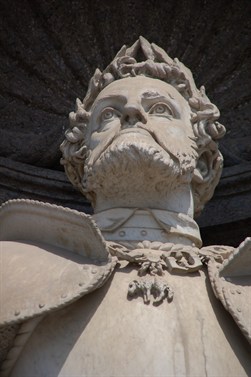Charles V of Habsburg
 Charles of Habsburg (1500-1558), as Emperor Charles V and Charles I as ruler of the Spanish Monarchy, concentrated a vast inheritance in his hands, fruit of the marriage policy orchestrated by his paternal grandfather, Maximilian I. Also the sovereign of the ancient Duchy of Burgundy, the kingdoms of Sardinia, Sicily and Naples and, starting from 1535, Duke of Milan, Charles was the centrepiece of an itinerant court. The main objectives of his international policy were military dominance in Europe, achieved at the expense of France, and the fight against the Protestant doctrine, the dissemination of which was officially sanctioned by the Peace of Augsburg (1555 ). As the head of the Spanish Monarchy, King Charles was often absent and he left the government in the hands of trusted men, such as the Secretary Mercurino Gattinara. Having quelled the revolt of the comuneros (1520-21), who had put his power at risk, Charles’s reign saw the formation of the system of Consejos which have long characterized the bureaucratic mechanism of the monarchy. After the abdication of 1556, which divided his dominions between his brother Ferdinand and his son Philip, he retired in Spain, until his death in the monastery of Yuste in 1558.
Charles of Habsburg (1500-1558), as Emperor Charles V and Charles I as ruler of the Spanish Monarchy, concentrated a vast inheritance in his hands, fruit of the marriage policy orchestrated by his paternal grandfather, Maximilian I. Also the sovereign of the ancient Duchy of Burgundy, the kingdoms of Sardinia, Sicily and Naples and, starting from 1535, Duke of Milan, Charles was the centrepiece of an itinerant court. The main objectives of his international policy were military dominance in Europe, achieved at the expense of France, and the fight against the Protestant doctrine, the dissemination of which was officially sanctioned by the Peace of Augsburg (1555 ). As the head of the Spanish Monarchy, King Charles was often absent and he left the government in the hands of trusted men, such as the Secretary Mercurino Gattinara. Having quelled the revolt of the comuneros (1520-21), who had put his power at risk, Charles’s reign saw the formation of the system of Consejos which have long characterized the bureaucratic mechanism of the monarchy. After the abdication of 1556, which divided his dominions between his brother Ferdinand and his son Philip, he retired in Spain, until his death in the monastery of Yuste in 1558.
Read more:
-
D. Lynch, Spain 1516-1598: from nation state to world empire, Oxford 1991.
-
A. Kohler, Karl V, 1500-1558. Eine Biographie, München 1999.
-
M. Fernández Álvarez, Carlos V, el césar y el hombre, Madrid 1999.
